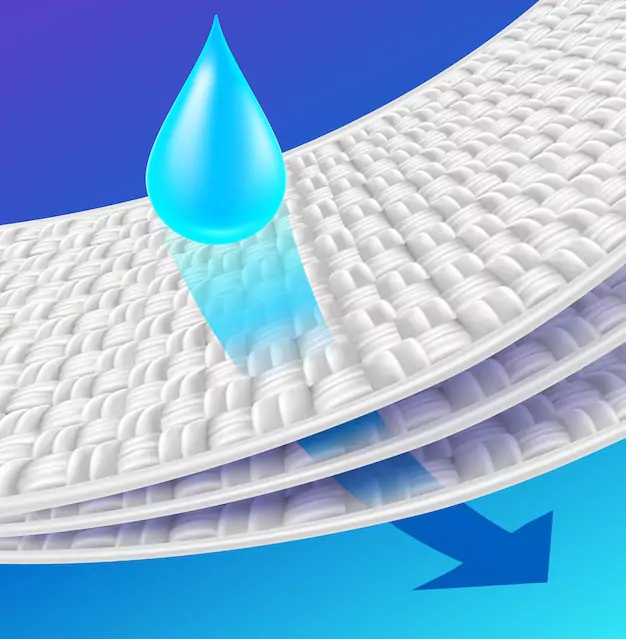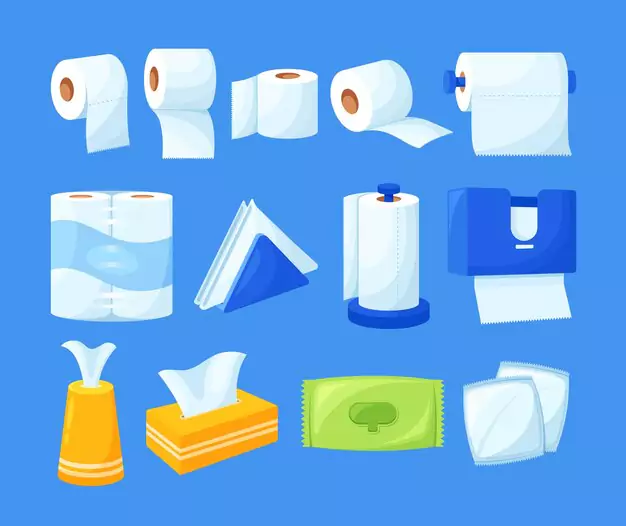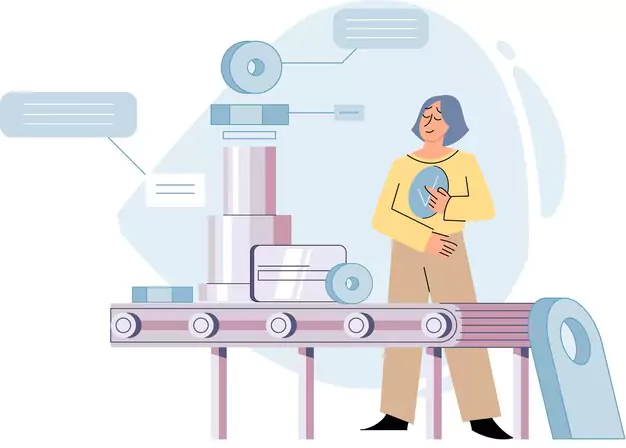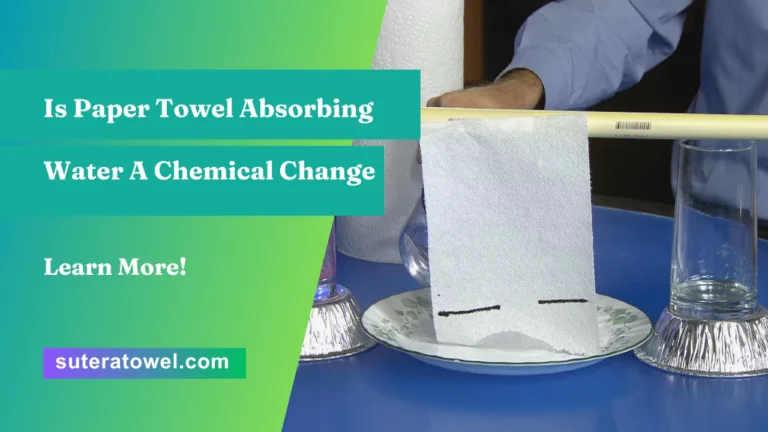Yes, paper towel absorbing water is a physical change, not a chemical change. Paper towels are made from cellulose fibers, which have the ability to absorb and hold water due to capillary action.
- 1 How Paper Towels Absorb Water
- 2 Is Water Absorption A Chemical Change In Paper Towels?
- 3 The Surprising Science Of Paper Towel’s Water Absorption
- 4 The Impact Of Different Paper Towel Brands On Water Absorption
- 5 Environmental Implications Of Paper Towel’s Water Absorption
- 6 Enhancing Water Absorption: Tips And Tricks
- 7 The Future Of Paper Towel Technology
- 8 Frequently Asked Questions Is Paper Towel Absorbing Water A Chemical Change
- 9 Conclusion
How Paper Towels Absorb Water

Paper towels absorb water through a process known as capillary action. When water comes into contact with the paper fibers, it is drawn upward, creating a chemical change that allows the paper towel to effectively soak up liquid.
When it comes to the science of paper towels and their ability to absorb water, it’s fascinating to dive into the structure and composition of these everyday household items. Understanding the process behind why paper towels can efficiently soak up spills and moisture can help us appreciate their usefulness even more.
So, let’s explore the structure and composition of paper towels and the science behind their water-absorbing capabilities.
Structure And Composition Of Paper Towels:
- Paper towels are made up of cellulose fibers, derived from wood pulp. These fibers give paper towels their strength and absorbency.
- The manufacturing process involves creating a network of interconnected fibers, resulting in the formation of small pores throughout the paper towel. These pores play a crucial role in the absorption of water.
- The composition of paper towels may vary, with some brands incorporating additional additives or chemicals to enhance absorbency or strength.
Capillary Action And Surface Tension Explained:
- Capillary action is an important phenomenon that contributes to the water-absorbing ability of paper towels. It occurs due to the attractive forces between water molecules and the fibers within the paper towel.
- The tiny pores in the paper towel act as capillaries, which help draw water upward against the force of gravity. This allows the water to be distributed throughout the towel, maximizing absorption.
- Surface tension also plays a role in the absorbency of paper towels. Water molecules have a strong attraction to each other, creating a “skin” on the surface of the liquid. Paper towels disrupt this skin, enhancing the absorption process.
The structure and composition of paper towels, combined with the principles of capillary action and surface tension, enable these everyday items to efficiently absorb water. Next time you reach for a paper towel to clean up a spill or dry your hands, take a moment to appreciate the science behind its water-absorbing prowess.
Is Water Absorption A Chemical Change In Paper Towels?
Water absorption by paper towels is a physical change rather than a chemical change. This process occurs due to the capillary action and porous structure of the paper towels, allowing them to soak up water without any chemical reactions taking place.
Evaluating Physical And Chemical Changes
When it comes to evaluating physical and chemical changes, it’s important to understand the properties of the materials involved. In this case, we’ll explore whether water absorption in paper towels can be considered a chemical change.
Exploring The Properties Of Paper Towels And Water:
- Paper towels are made from cellulose fibers derived from trees.
- The fibers are woven together to create a porous structure that allows for quick absorption.
- The absorbency of paper towels is enhanced by a process called creping, which creates tiny air pockets within the fibers.
- These air pockets increase the surface area of the paper towel, allowing for greater contact with water.
- Paper towels are designed to be hydrophilic, meaning they have an affinity for water molecules.
- Water molecules are polar, and their positive and negative charges attract to the cellulose fibers in the paper towel, causing absorption.
- No, water absorption in paper towels is not a chemical change but a physical one.
- In a chemical change, the substances involved undergo a chemical reaction, resulting in the formation of new substances with different properties.
- In the case of water absorption, no new substances are formed.
- The cellulose fibers in the paper towel simply attract and hold onto the water molecules.
- This physical change can be reversed by drying the paper towel or applying pressure to squeeze out the water.
The absorption of water in paper towels is a physical change that occurs due to the properties of both the paper towel and water. It is not a chemical change as there is no chemical reaction or formation of new substances.
Understanding these concepts can help us appreciate the science behind everyday materials like paper towels.
The Surprising Science Of Paper Towel’s Water Absorption
Paper towels’ water absorption is not a chemical change but a physical one. The surprising science behind it lies in the towel’s porous structure, which allows it to absorb water efficiently.
Paper Towel’s Water Absorption: The Science Unveiled
Have you ever wondered how paper towels are able to absorb water so efficiently? It may seem like a simple process, but there is actually some fascinating science behind it. In this blog post, we will explore the surprising science of paper towel’s water absorption and delve into the role of cellulose fibers and additives in enhancing their absorption capacity.
So, let’s dive right in!
Investigating The Role Of Cellulose Fibers
Cellulose fibers, derived from plants, are a key component of paper towels and play a crucial role in their water absorption capabilities. Here’s a closer look at how these fibers contribute to the absorbent nature of paper towels:
- Interconnected network: Cellulose fibers form an interconnected network within the paper towel structure, creating small capillary channels. These channels act like tiny straws, allowing water to be drawn up and held within the towel.
- High surface area: The fibrous structure of cellulose provides paper towels with a large surface area. This increased surface area enables them to come into contact with more water molecules, effectively soaking up a greater amount of liquid.
- Hydrophilic properties: Cellulose fibers have hydrophilic properties, meaning they have a strong affinity for water molecules. As a result, they readily attract and retain water, allowing paper towels to efficiently absorb spills or moisture.
Understanding The Impact Of Additives On Absorption Capacity
While cellulose fibers are primarily responsible for paper towel’s water absorption, the incorporation of additives can further enhance their absorption capacity. Let’s explore some common additives and how they impact the absorbent qualities of paper towels:
- Surface modifiers: Additives like surfactants or wetting agents can be added to paper towels to lower surface tension. This allows water to spread more easily over the towel’s surface, increasing its absorbency.
- Strengthening agents: Some paper towel manufacturers incorporate strengthening agents, like chemicals or synthetic polymers, to enhance the towel’s structural integrity. By reinforcing the cellulose fibers, these additives prevent the towel from breaking apart when saturated with water.
- Softening agents: Softening agents, such as lotions or oils, can be applied to paper towels to provide a gentle touch. While these additives may not directly impact water absorption, they contribute to the overall user experience.
- Colorants and fragrances: While not directly related to water absorption, colorants and fragrances are often added to paper towels for aesthetic appeal. They don’t affect the towel’s ability to absorb water but can make the drying process a more pleasant experience.
Understanding the intricate science behind paper towels‘ water absorption sheds light on why they are so effective at quickly soaking up spills and moisture. The combination of cellulose fibers and carefully selected additives allows paper towels to perform their essential role in our daily lives.
So, the next time you reach for a paper towel, take a moment to appreciate the remarkable science behind its water-absorbing powers.
The Impact Of Different Paper Towel Brands On Water Absorption

Different paper towel brands have varying impacts on water absorption. Exploring whether paper towel absorption is a chemical change reveals intriguing insights into the effectiveness of these brands.
Absorption is a crucial factor to consider when choosing paper towels. Different brands have varying abilities to soak up water efficiently. In this section, we will dive into the impact of different paper towel brands on water absorption. By comparing various brands and examining the significance of fiber density and structure, we can gain valuable insights into the effectiveness of different paper towels.
So, let’s explore further!
Comparing Various Brands And Their Absorption Properties:
- Brand A:
- Absorption: This brand is known for its excellent water absorption capabilities. The fibers in Brand A are tightly packed, allowing for effective water retention.
- Durability: The strong fibers in Brand A make it highly durable, ensuring it can handle substantial amounts of liquid without falling apart.
- Brand B:
- Absorption: Brand B’s paper towels have moderate absorption properties. The fibers are not as densely packed as in Brand A, leading to slightly lower water retention.
- Softness: One advantage of Brand B is its softness, which makes it gentle on surfaces while still being able to absorb liquids.
- Brand C:
- Absorption: Brand C offers good water absorption capabilities. The paper towels are made from dense fibers, allowing for efficient water retention.
- Environmental friendliness: Brand C takes pride in its environmentally friendly practices, using recyclable materials and reducing waste.
Examining The Significance Of Fiber Density And Structure:
- Fiber density:
- High fiber density results in better water absorption due to the increased number of fibers available for soaking up liquid.
- Low fiber density can hinder absorption as fewer fibers are available to retain water.
- Fiber structure:
- Open and porous fiber structures allow for increased water flow and absorption.
- Tight and packed fiber structures can limit water absorption as there is less space for liquid to penetrate.
By considering the absorption capabilities of different paper towel brands and understanding the impact of fiber density and structure, you can make an informed choice when selecting paper towels for your specific needs. Whether you prioritize absorbency, durability, softness, or environmental friendliness, knowing the differences between brands will help you find the ideal paper towel for your tasks.
Environmental Implications Of Paper Towel’s Water Absorption
Paper towels‘ water absorption raises environmental concerns due to the potential chemicals involved. Understanding whether it is a chemical change is crucial in evaluating the impact on nature.
When it comes to the environmental impact of paper towel absorption, it’s essential to consider factors like biodegradability and sustainable alternatives. Let’s delve into these topics to understand the implications better.
Investigating The Biodegradability Of Paper Towels
- Paper towels are typically made from wood pulp, which is a renewable resource. However, the manufacturing process involves chemicals and energy consumption.
- The biodegradability of paper towels is an important aspect to consider. Here’s what you need to know:
- Paper towels can break down over time when they are exposed to moisture and microorganisms in the environment.
- The decomposition process can vary depending on factors like the quality of the paper towel and the conditions in which it is disposed of.
- If paper towels end up in landfill sites where oxygen and sunlight are limited, the biodegradation process may take longer.
Discussing Sustainable Alternatives To Paper Towels
Using sustainable alternatives to paper towels can significantly reduce the environmental impact. Consider the following options:
- Reusable cloth towels:
- Cloth towels, such as microfiber or cotton, can be washed and reused multiple times, reducing waste.
- These towels are typically more durable than paper towels and can handle multiple uses before needing to be replaced.
- Bamboo towels:
- Bamboo towels are made from renewable bamboo fibers and are biodegradable.
- They offer the same absorbency as paper towels but with a lower environmental impact.
- Air dryers:
- Air dryers can be an effective solution for hand drying in public bathrooms, reducing the need for paper towels altogether.
- They use electricity to blow air rather than relying on disposable paper products.
By considering the biodegradability of paper towels and exploring sustainable alternatives, we can make more environmentally conscious choices. Switching to reusable cloth towels, bamboo towels, or utilizing air dryers can significantly reduce waste and contribute to a more sustainable future.
Enhancing Water Absorption: Tips And Tricks
Discover effective tips and tricks for enhancing water absorption, including whether paper towel absorbing water is a chemical change. Learn how to maximize water absorption efficiently and improve your everyday tasks.
Is paper towel absorbing water considered a chemical change? This is a question that often comes up when discussing the science behind water absorption. In this section, we will explore practical strategies to maximize the absorption capacity of paper towels.
By utilizing techniques such as folding and layering, you can enhance the water absorption capabilities of this common household item.
Practical Strategies To Maximize Paper Towel Absorption:
- Fold the paper towel: By folding the paper towel, you create layers that allow for better water absorption. The folds increase the surface area of the towel, providing more contact with the water. This, in turn, enhances the absorption rate.
- Layer the paper towels: Adding multiple layers of paper towels can significantly improve absorption. Each layer works together to absorb the water, increasing the overall capacity. Simply place one paper towel on top of another and press them together firmly to create a barrier that prevents water from seeping through.
- Use a textured paper towel: Opt for paper towels with a textured surface. These towels have small bumps or ridges that help to trap and hold the water. The texture enhances the capillary action, allowing the towel to draw in more water.
- Apply pressure: Applying gentle pressure to the paper towel can increase absorption. Whether it’s squeezing the towel with your hands or using a heavy object to press down, the added pressure helps to extract more water from the material.
- Wet the paper towel before use: If you’re dealing with particularly stubborn spills or stains, dampening the paper towel before use can enhance water absorption. The moisture can break down some substances, making it easier for the towel to pick them up.
- Choose a high-quality paper towel: Not all paper towels are created equal. Invest in a higher-quality brand that is specifically designed for maximum absorption. These towels have superior fibers and construction, allowing them to absorb water more efficiently.
By employing these practical strategies, you can make the most out of your paper towel’s absorption capabilities. Whether you’re cleaning up spills, drying surfaces, or tackling everyday messes, these techniques will ensure that your paper towels perform at their best.
Remember to fold, layer, and apply pressure to maximize absorption and get the most out of this versatile cleaning tool.
The Future Of Paper Towel Technology

Paper towel technology is advancing rapidly with the goal of maximizing water absorption. Explore whether paper towel absorbing water is a chemical change and how it impacts future advancements in this field.
Innovations in paper towel design for improved absorption:
- Advanced Textures: Paper towel manufacturers are constantly exploring new textures to enhance absorbency. By incorporating unique patterns or embossing techniques, these towels can effectively capture and hold liquid, providing optimal absorption.
- Reinforced Strength: Engineers are developing stronger paper towel fibers to withstand wet conditions. This improvement ensures that the towel doesn’t break apart when absorbing large amounts of liquid, making it a more reliable option.
- Absorbent Additives: Researchers are experimenting with additives to enhance paper towel absorbency. These additives include substances like cellulose fibers, superabsorbent polymers, and even natural ingredients like bamboo or coconut fibers to increase the towel’s ability to soak up moisture.
Exploring alternative materials and solutions:
- Eco-Friendly Alternatives: With environmental concerns rising, paper towel manufacturers are exploring alternative materials that are more sustainable. Some companies have introduced paper towels made from recycled paper or even bamboo, which is known for its rapid growth and low environmental impact.
- Nanotechnology: The integration of nanotechnology has opened doors for paper towel innovation. Nanofibers, which are incredibly thin and have a high surface area, allow for increased absorption capacity and faster drying time. This technology enhances the overall performance and efficiency of paper towels.
- Reusability: In an effort to reduce waste, some companies are developing reusable paper towels that can withstand multiple uses. These towels are typically made from durable and washable materials and are an effective way to minimize environmental impact.
The future of paper towel technology is promising, with continuous advancements being made to improve absorption, sustainability, and overall user experience. Through innovative designs and alternative materials, paper towels are becoming more efficient, eco-friendly, and practical for everyday use.
Frequently Asked Questions Is Paper Towel Absorbing Water A Chemical Change
What Chemical Absorbs Water In Paper Towels?
The chemical that absorbs water in paper towels is often a superabsorbent polymer.
Is Absorbing A Chemical Or Physical Change?
Absorbing a chemical or physical change is considered a physical change.
How Is Water Being Absorbed By Paper Towel Physical Change?
When water contacts paper towels, it is absorbed through a physical change process.
Is Paper Soaked In Water A Chemical Change?
Yes, when paper gets soaked in water, it undergoes a chemical change.
Conclusion
The absorbency of paper towel, a common household staple, is not a result of a chemical change, but rather a physical one. As water comes into contact with the paper fibers, capillary action and adhesion cause the liquid to be drawn into the small spaces between the fibers.
This results in the water being held within the paper towel, making it an effective tool for cleaning up spills and drying surfaces. Understanding the science behind paper towel absorbency can lead to innovative advancements in materials and engineering. By studying the properties of paper fibers and how they interact with liquids, scientists can develop more absorbent materials for various applications.
In our daily lives, having an understanding of the difference between chemical and physical changes can help us make informed decisions. Knowing that paper towel absorbency is a physical change allows us to utilize this resource efficiently and be conscious of environmental concerns.
So, the next time you reach for a paper towel to clean up a spill, remember that it’s the physical properties of the paper fibers, not a chemical reaction, that allows it to effectively soak up the liquid.
